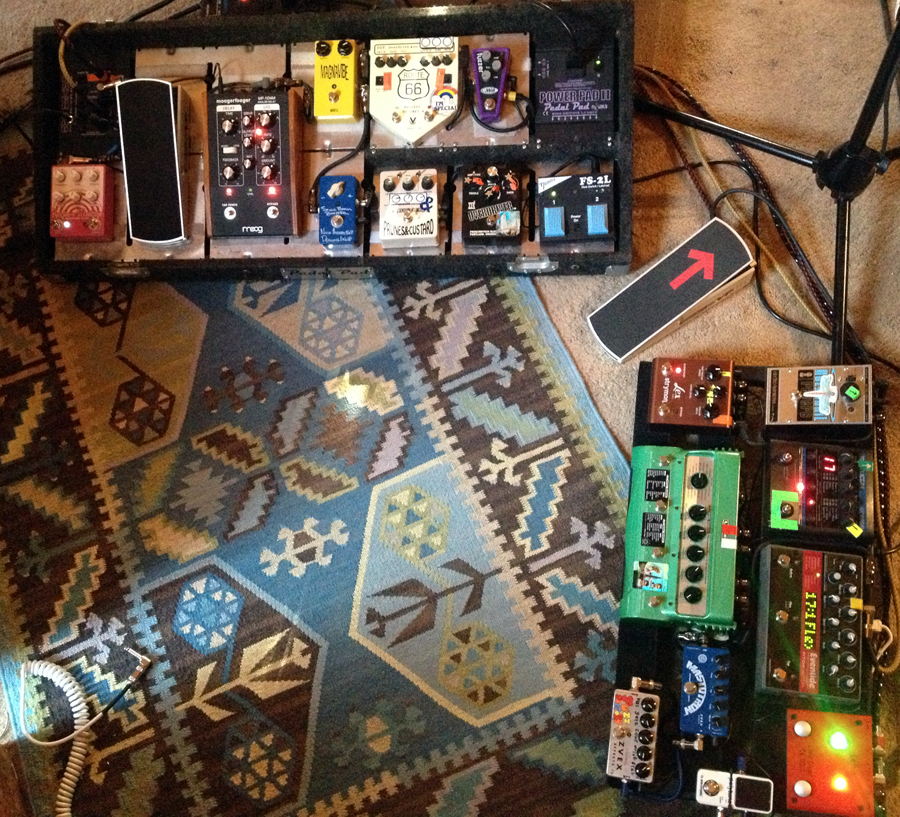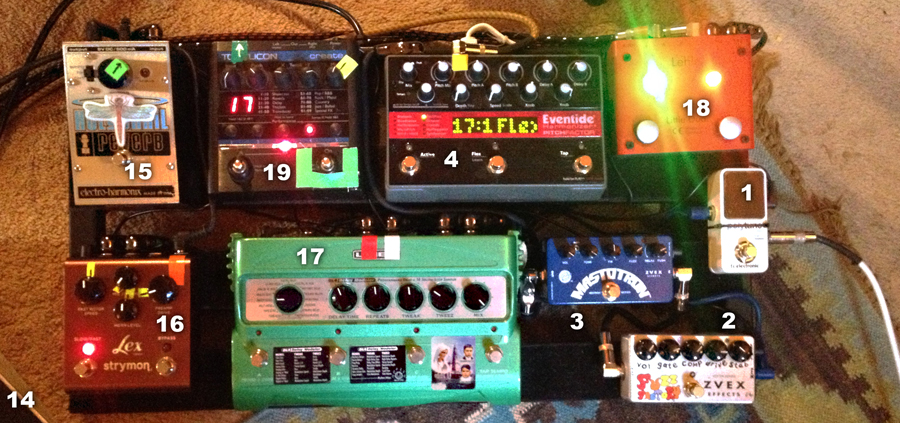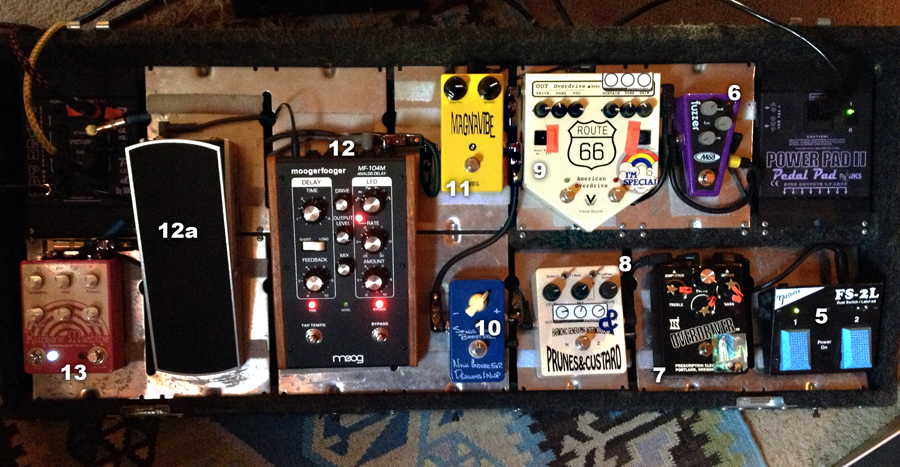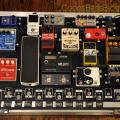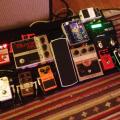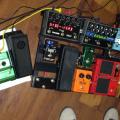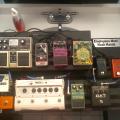Today’s pedal line is from Sam Cooper. If you have a pedal line (doesn’t have to be in a board) for your rig, please email me a photo, bio, description of pedals and routing to pedalline@nulleffectsbay.com. Every Friday I’ll showcase a pedal line submission. Make sure you include any links to your band or music page.
SIGNAL CHAIN:
Guitar >
{Little Board}
TC Electronics Polytune Mini > Z.Vex Vexter Fuzz Factory > Z.Vex Vexter Mastotron > Eventide PitchFactor >
{Big Board}
ModTone Mini-Mod Fuzzer > Prescription Electronics Overdriver > Crowther Audio Prunes & Custard > Visual Sound Route 66 Overdrive/Compression > Nick Greer Sonic Boom Boost > Bigfoot FX Magnavibe > Moog Moogerfooger MF-104M Analog Delay > Earthquaker Devices Rainbow Machine >
Ernie Ball Jr. passive volume pedal (floating between boards) >
{Back to Little Board}
Electro-Harmonix Holy Grail Reverb > Strymon Lex > Line 6 DL4 Delay Modeler > Lehle Little Dual switcher >
Amps:
Fender ’65 Deluxe Reverb Reissue (with reverb and tremolo controlled by Nobels FS-2L on Big Board)
Vox AC-15 CC1
SOME MORE WORDS:
1. Â TC Electronics Polytune Mini
It’s a tuner. It gets the job done.
2. Z.Vex Vexter Fuzz Factory
I need my fuzzes versatile and as loud as possible. This fits the bill nicely. I don’t really mind the unpredictability/sensitivity of the circuit; a quick sound check will get it where it needs to be. Although I set mine to be relatively gated, I can usually coax some nearly endless sustain out of this beautiful germanium baby.
3. Z.Vex Vexter Mastotron
I’m a big St. Vincent fan, and love her fuzz sound, which comes from a Mastrotron. I have mine set up to spew nasty, squeezed, squelchy, silicon trash fuzz. Mmmmm. One and only complaint: could be louder. Oh well.
4. Eventide PitchFactor
Oh man… so versatile. The straight-up pitch shifting is magical and musical—with a sound dinstinct from a Whammy or POG—and can make my guitar sound like a drawbar organ or portamento synth. But where this unit really shines as a creative tool is in its pitch sequencing and delay offerings. Whole songs can be written around these sounds (and have been).
5. Nobels FS-2L Latching footswitch
I use my Fender ’65 DRRI’s onboard reverb and tremolo a lot, and used to use the supplied footswitch to operate them. But I wanted something with LEDs so that I could, at a glance, with my volume killed, see what was on. This was the solution.
6. ModTone Mini-Mod Fuzzer
I bought this on a whim for 40 bucks in an online sale, not thinking I’d use it much. It is now a cornerstone of my sound. It is loud as hell, and has an unbelievable tonal range. It’s marketed as being able to reproduce John Lennon’s straight-into-the-mixing-board distortion from “Revolution†(which it definitely can), but I turn down the fuzz and the tone control all the way for a honky, slightly muffled, QOTSA-like mid-range-boost sound that’s almost more like an overdrive than a fuzz.
7. Prescription Electronics Overdriver
My two biggest guitar heroes are Neil Young and Jeff Tweedy. Both are known to traffic in skronky, super-compressed, molten-iron lead tones. This pedal does that. And oh yeah, IT’S LOUD. (I had an LED indicator added to this, and put that giant knob on the top.)
8. Crowther Audio Prunes & Custard
This is another one purchased as a result of Jeff-Tweedy-worship. I don’t have a whole lot of interest in what a lot of guitarists seem to be looking for in tone: smooth, creamy, sweet, whatever. So I love this pedal. For those who don’t know, it’s essentially a high-gain overdrive with a second-stage filter that makes synth-like overtones and weird harmonic modulation between notes.
9. Visual Sound Route 66 Overdrive/Compression
This is, in my opinion, a shamefully under-used pedal in the music world at large. It’s essentially a slightly modded TS808 and a Dyna/Ross compressor squashed together. The overdrive side in particular is essential to my playing. It’s just a great, classic, aggressive, high-gain workhorse.
10. Nick Greer Sonic Boom Boost
I’m not sure this is a totally clean boost, as it’s advertised; I hear a slight mids-boost when the pedal’s set to unity gain. It’s got one knob, something like +20dB of gain. I use it to push my amps into distortion, which it does fantastically.
11. Bigfoot FX Magnavibe
I record a lot with my two vintage amps: a Supro Super 1606 and a Magnatone 213-A Troubadour, both dated 1960. The Magnatone features the famous “golden voiceâ€â€”true pitch-shifting electronic vibrato—and this pedal comes very close to replicating it. Since I never play out with my vintage amps, this pedal is a must for recreating those wiggly Magnatone sounds live.
12. Moog Moogerfooger MF-104M Analog Delay
(12a. Ernie Ball Jr. as expression pedal)
This is the newest and coolest addition to my rig. I’ve wanted one for about 10 years. When the new version came out a few months ago, I couldn’t afford it. But some savvy eBay scouring and the sales of some other gear made my dreams come true. It’s the Rolls Royce of analog delays. And it looks like a spaceship.
13. Earthquaker Devices Rainbow Machine
I hate chorus. I really do. And I don’t have much use for flangers or phasers either. So when I got this, I thought I’d use it the most for the weird video game noises and fairy-dust effects. But I’ve ended up using it for a sickening, detuned chorus effect. Go figure. I guess it’s just messed up enough for me to love it.
14. Ernie Ball Jr. volume pedal
It makes things louder or quieter. A lot of people bitch about these things being unreliable. And yeah, I’ve broken the string mechanism a few times in a couple units. But I think their feel and action is unbeatable.
15. Electro-Harmonix Holy Grail Reverb
Since I use my Fender amp’s onboard reverb for more subtle, groovy spring-reverb textures, I set the Holy Grail to the “hall†setting and turn the knob up high. It makes my guitar sound melted.
16. Strymon Lex
This is an incredibly realistic Leslie speaker emulator, with controls over such detailed parameters as the “mic†“distance†from the “cabinet.†I bought this thinking it would be a cool occasional texture, but I’ve ended up using it constantly.  Remember when I said I hate chorus, flangers, and phasers? Well this thing is a classy way to get some more non-standard modulation into my rig. Because I play through two amps in stereo, I can split the signal from the Lex for some seriously psychedelic swirliness.
17. Line 6 DL4 Delay Modeler
I use this for really long delays, slapback tape echoes, stereo delays, and looping. It’s a great pedal and is so ubiquitous for a reason.
18. Lehle Little Dual switcher
This little German gizmo keeps my amps electrically isolated. It’s got a handy phase-switching button, and the brightest LEDs I’ve ever seen.
19. TC Helicon VoiceCreate
This is my vocal effects unit.
Other notes:
- The little board is powered by a Voodoo Labs Pedal Power II Plus. The big board is powered by the MKS Power Pad II.
- Why make my signal travel back and forth between two boards twice? Because I’ve optimized the little board to be, with one or two swaps, suitable as a standalone electric or acoustic rig.
- The assorted religious, children’s, and doctor’s office stickers are the secret to my tone.
Sam Cooper is a singer/songwriter/multi-instrumentalist who leads the band Sam Cooper & The Sleepwalkers. Find out more about them here: www.samcoopersleepwalkers.com
-
11 years ago
Interesting, so you put pitch after fuzz too. I did that w/ a POG2 and Fuzz Factory without really thinking it out. Seems wrong but it works!
Reply -
11 years ago
Eric– Yeah, I put the Pitchfactor there for maximum flexibility. In that position, is has a couple of fuzzes before it (to pitch-shift their harmonics to interesting effect), and a fuzz and a few overdrive after it (for a more natural pitch-shifted gain sound). Sometimes the wrongest things can be oh so right!
Reply -
8 years ago
Sam – How does that “Pedal Pad” board work out under the big board pedals ?? — Thanks — JB
Reply

